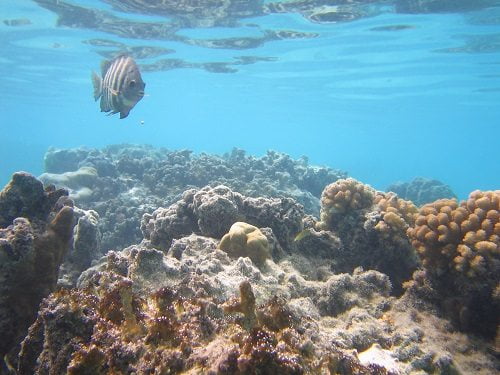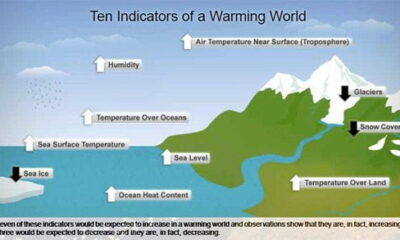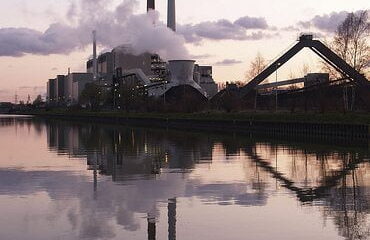

Environment
NOAA declares third ever global coral bleaching event
As record ocean temperatures cause widespread coral bleaching across Hawaii, US National Oceanic and Atmospheric Administration (NOAA) scientists confirm the same stressful conditions are expanding to the Caribbean and may last into the new year, prompting the declaration of the third global coral bleaching event ever on record. First published here.
Waters are warming in the Caribbean, threatening coral in Puerto Rico and the U.S. Virgin Islands, NOAA scientists said. Coral bleaching began in the Florida Keys and South Florida in August, but now scientists expect bleaching conditions there to diminish.
“The coral bleaching and disease, brought on by climate change and coupled with events like the current El Niño, are the largest and most pervasive threats to coral reefs around the world,” said Mark Eakin, NOAA’s Coral Reef Watch coordinator. “As a result, we are losing huge areas of coral across the U.S., as well as internationally. What really has us concerned is this event has been going on for more than a year and our preliminary model projections indicate it’s likely to last well into 2016.”
While corals can recover from mild bleaching, severe or long-term bleaching is often lethal. After corals die, reefs quickly degrade and the structures corals build erode. This provides less shoreline protection from storms and fewer habitats for fish and other marine life, including ecologically and economically important species.
This bleaching event, which began in the north Pacific in summer 2014 and expanded to the south Pacific and Indian oceans in 2015, is hitting U.S. coral reefs disproportionately hard. NOAA estimates that by the end of 2015, almost 95 percent of U.S. coral reefs will have been exposed to ocean conditions that can cause corals to bleach.
The biggest risk right now is to the Hawaiian Islands, where bleaching is intensifying and is expected to continue for at least another month. Areas at risk in the Caribbean in coming weeks include Haiti, the Dominican Republic and Puerto Rico, and from the U.S. Virgin Islands south into the Leeward and Windward islands.
The next concern is the further impact of the strong El Niño, which climate models indicates will cause bleaching in the Indian and southeastern Pacific Oceans after the new year. This may cause bleaching to spread globally again in 2016.

Extensive stand of severely bleached coral at Lisianski Island in Papahanaumokuakea Marine National Monument (Hawaii) documented during an August 2014 NOAA research mission. (Credit: NOAA)
“We need to act locally and think globally to address these bleaching events. Locally produced threats to coral, such as pollution from the land and unsustainable fishing practices, stress the health of corals and decrease the likelihood that corals can either resist bleaching, or recover from it,” said Jennifer Koss, NOAA Coral Reef Conservation Program acting program manager. “To solve the long-term, global problem, however, we need to better understand how to reduce the unnatural carbon dioxide levels that are the major driver of the warming.”
This announcement stems from the latest NOAA Coral Reef Watch satellite coral bleaching monitoring products, and was confirmed through reports from partner organizations with divers working on affected reefs, especially the XL Catlin Seaview Survey and ReefCheck. NOAA Coral Reef Watch’s outlook, which forecasts the potential for coral bleaching worldwide several months in the future, predicted this global event in July 2015.
The current high ocean temperatures in Hawaii come on the heels of bleaching in the Main Hawaiian Islands in 2014 ― only the second bleaching occurrence in the region’s history ― and devastating bleaching and coral death in parts of the remote and well-protected Papahānaumokuākea Marine National Monument in the Northwestern Hawaiian Islands.
“Last year’s bleaching at Lisianski Atoll was the worst our scientists have seen,” said Randy Kosaki, NOAA’s deputy superintendent for the monument. “Almost one and a half square miles of reef bleached last year and are now completely dead.”
Coral bleaching occurs when corals are exposed to stressful environmental conditions such as high temperature. Corals expel the symbiotic algae living in their tissues, causing corals to turn white or pale. Without the algae, the coral loses its major source of food and is more susceptible to disease.
The first global bleaching event was in 1998, during a strong El Niño that was followed by an equally very strong La Niña. A second one occurred in 2010.
Satellite data from NOAA’s Coral Reef Watch program provides current reef environmental conditions to quickly identify areas at risk for coral bleaching, while its climate model-based outlooks provide managers with information on potential bleaching months in advance.
The outlooks were developed jointly by NOAA’s Satellite and Information Service and the National Centers for Environmental Prediction through funding from the Coral Reef Conservation Program and the Climate Program Office.
NOAA’s mission is to understand and predict changes in the Earth’s environment, from the depths of the ocean to the surface of the sun, and to conserve and manage our coastal and marine resources. Join us on Facebook, Twitter, Instagram and our other social media channels.


 Environment10 months ago
Environment10 months agoAre Polymer Banknotes: an Eco-Friendly Trend or a Groundswell?

 Environment12 months ago
Environment12 months agoEco-Friendly Home Improvements: Top 7 Upgrades for 2025

 Features9 months ago
Features9 months agoEco-Friendly Cryptocurrencies: Sustainable Investment Choices

 Features10 months ago
Features10 months agoEco-Friendly Crypto Traders Must Find the Right Exchange






























